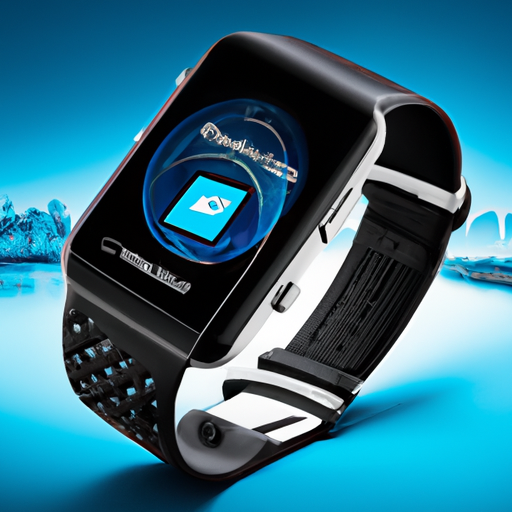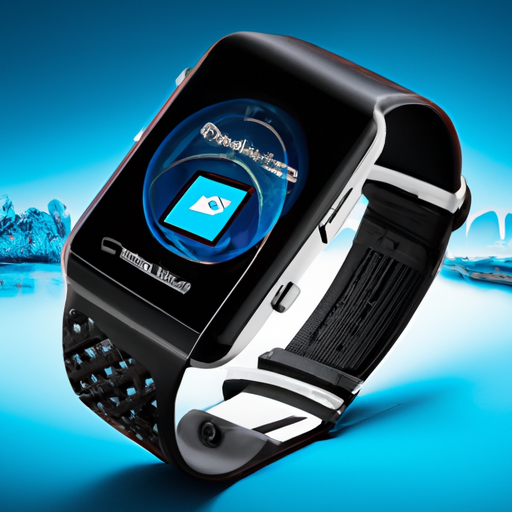In the world of technology, smartwatches have quickly become a ubiquitous accessory, adorning the wrists of tech-savvy individuals who crave both style and functionality. But have you ever wondered how these tiny devices work their magic? Brace yourself as we embark on an exploratory journey into the captivating realm of smartwatches and unravel the exquisite science behind their intricate mechanisms.
In this article, we will delve into the inner workings of smartwatches, revealing the fascinating technology that brings them to life. From the cutting-edge sensors that monitor your vitals to the sleek display that showcases notifications, we will uncover the secrets behind these remarkable gadgets. So whether you already own a smartwatch or are simply intrigued by their allure, prepare to satisfy your curiosity and gain a deeper understanding of the science behind how these ingenious devices function.

Sensors
Accelerometer
The accelerometer is a fundamental sensor in a smartwatch that measures acceleration. It tracks your movements and orientation in three-dimensional space. This sensor enables features like step counting, activity recognition, and sleep tracking. By understanding your movement patterns, the smartwatch can provide valuable insights into your daily activities and help you stay active.
Gyroscope
The gyroscope is another sensor found in most smartwatches. It measures rotation and orientation, providing data on how the smartwatch is moving in space. This sensor is particularly useful for features like gesture controls and gaming applications. It enhances the user experience by allowing you to interact with the smartwatch through natural movements.
Heart Rate Sensor
Smartwatches often incorporate a heart rate sensor, typically located on the underside of the device. This sensor uses photoplethysmography (PPG) to measure your heart rate by illuminating the blood vessels in your wrist and detecting the variations in blood volume. Monitoring your heart rate can help track your fitness levels, stress levels, and even identify potential health concerns.
GPS
Smartwatches equipped with GPS have the ability to track your location accurately. By leveraging signals from multiple satellites, the smartwatch can determine your latitude, longitude, and altitude. GPS is essential for outdoor activities like running, cycling, or hiking, as it enables features such as route tracking, pace calculation, and distance measurement. It also improves the accuracy of other fitness-related measurements.
Ambient Light Sensor
The ambient light sensor adjusts the brightness of the smartwatch display based on the surrounding lighting conditions. It ensures that the display remains readable and comfortable to view in different environments. By automatically optimizing brightness levels, the ambient light sensor conserves battery life and enhances the user experience by reducing eye strain.
Operating System
Interface
The operating system (OS) provides the foundation for how you interact with your smartwatch. It determines the user interface design, the accessibility of features, and the overall user experience. Whether it’s a proprietary OS or a popular platform like Apple’s watchOS or Google’s Wear OS, the interface plays a vital role in making the smartwatch intuitive and easy to use.
App Support
Just like smartphones, smartwatches can run various apps that extend their functionality beyond the pre-installed features. App support allows you to customize your smartwatch experience and access a wide range of additional features. From fitness tracking and productivity apps to music streaming and navigation services, the availability of apps on a smartwatch enhances its versatility and utility.
Connectivity
Connectivity is crucial for a smartwatch to stay connected to other devices and the internet. Most smartwatches offer Bluetooth connectivity, allowing you to connect to your smartphone and receive notifications, control music playback, or even make calls. Wi-Fi connectivity enables independent functionality, such as downloading apps or streaming music directly to the smartwatch. NFC (Near Field Communication) enables contactless payments, allowing you to make purchases conveniently using your smartwatch.
Display
Types of Display
Smartwatches employ various types of displays, including AMOLED, LCD, and E-Ink. AMOLED displays offer vibrant colors, deep blacks, and high contrast, resulting in an immersive visual experience. LCD displays provide good visibility in bright conditions and tend to be more power-efficient. E-Ink displays are commonly found in hybrid smartwatches, resembling the look of a traditional analog watch while offering extended battery life.
Touchscreen Technology
Most modern smartwatches utilize touchscreen technology for intuitive interaction. Capacitive touchscreens are the most commonly used type, offering a responsive and precise touch experience. Some smartwatches also incorporate additional features, such as haptic feedback, which provides tactile sensations when interacting with the touchscreen. This enhances the overall usability and user experience of the smartwatch.
Battery and Power Management
Battery Life
Battery life is a critical factor to consider when choosing a smartwatch. The battery life varies depending on the smartwatch model, usage patterns, and features utilized. On average, smartwatches can last one to several days on a single charge. Manufacturers continuously strive to improve battery life through hardware optimizations and power management techniques. Some smartwatches also offer power-saving modes to extend battery life further.
Charging Methods
Smartwatches typically charge using a magnetic charger or a wireless charging dock. The charging time varies depending on the battery capacity and the charging technology employed. Fast charging features enable you to quickly top up the battery when needed. Some smartwatches also support wireless power sharing, allowing you to charge your smartwatch using your smartphone’s wireless charging capabilities.

Connectivity
Bluetooth
Bluetooth connectivity is a fundamental feature of smartwatches. It enables seamless communication between the smartwatch and other devices like smartphones, tablets, or headphones. By connecting to your smartphone, the smartwatch can receive notifications, control music playback, and even make calls. Bluetooth technology plays a crucial role in integrating the smartwatch into your digital ecosystem.
Wi-Fi
Wi-Fi connectivity offers independent functionality to smartwatches. It allows the smartwatch to connect to the internet directly, enabling features such as app downloads, software updates, or streaming music. With Wi-Fi connectivity, you can use your smartwatch even when your smartphone is out of range, providing a versatile and standalone experience.
NFC
NFC technology allows for contactless communication between your smartwatch and other NFC-enabled devices. One of the key applications of NFC on a smartwatch is contactless payment. By securely storing your payment information, you can make purchases conveniently using your smartwatch, eliminating the need for carrying a physical wallet. NFC also enables quick pairing with compatible devices and simplified data transfer between devices.
Fitness Tracking
Step Counting
Smartwatches with an accelerometer sensor can accurately track your steps throughout the day. Step counting is one of the basic fitness tracking features and helps you monitor your daily activity level. By setting goals and tracking your progress, smartwatches motivate you to stay active and achieve a healthier lifestyle.
Calorie Tracking
By combining data from sensors like the accelerometer and heart rate sensor, smartwatches estimate the number of calories burned throughout the day. Calorie tracking provides valuable insights into your energy expenditure and helps you maintain a balanced diet and exercise routine.
Exercise Recognition
Smartwatches equipped with advanced sensors and machine learning algorithms can automatically recognize specific exercises or activities. Whether you are running, cycling, or doing yoga, the smartwatch can detect and track your workouts. This feature allows you to effortlessly monitor your exercise sessions without manually entering the details into the smartwatch.

Notifications and Communication
Call and Message Alerts
Smartwatches act as an extension of your smartphone by displaying call and message notifications directly on your wrist. You can see who is calling or texting without taking out your phone. Some smartwatches even allow you to answer or decline calls directly from your wrist. This feature enhances convenience and ensures that you never miss an important communication.
Social Media Notifications
Stay connected with your favorite social media platforms through smartwatch notifications. Receive notifications from apps like Facebook, Twitter, or Instagram directly on your wrist. Whether it’s a new message, a like, or a comment, you can stay informed and engaged with your social media accounts without constantly checking your smartphone.
Health Monitoring
Sleep Tracking
Smartwatches with sleep tracking capabilities monitor your sleep patterns, including sleep duration, sleep stages, and sleep quality. By analyzing your sleep data, the smartwatch can provide personalized insights and recommendations to improve your sleep habits. Sleep tracking helps you understand your sleep patterns, identify factors that affect your sleep quality, and make necessary adjustments for better rest.
Heart Rate Monitoring
Heart rate monitoring is a key health feature offered by smartwatches. By continuously measuring your heart rate, these devices provide real-time data on your heart rate variability, resting heart rate, and maximum heart rate. Monitoring your heart rate during workouts helps optimize your training intensity, while resting heart rate measurements provide insights into your overall cardiovascular health.
Blood Oxygen Level
Some advanced smartwatches are equipped with a SpO2 sensor, which measures your blood oxygen level. This metric indicates how effectively your respiratory and circulatory systems are delivering oxygen to your body. Monitoring your blood oxygen levels can help identify early signs of respiratory conditions or other health issues, enabling proactive intervention and care.

Water Resistance
IP Ratings
Water resistance is an important feature for smartwatches, allowing you to use the device in various water-related activities without worrying about damage. Smartwatches are often rated using the IP (Ingress Protection) system, indicating their resistance to water and dust. For example, an IP68 rating ensures protection against water immersion up to a certain depth and duration.
Swim Tracking
Smartwatches designed for water activities often offer dedicated swim tracking features. These watches can accurately track your swimming statistics, such as lap count, total distance swam, and stroke type. With swim tracking, you can monitor your progress, set goals, and enhance your swimming performance.
Design and Customization
Watch Bands
Smartwatches offer various watch band options, allowing you to customize the look and feel of your device. From sporty silicone bands to elegant metal bracelets or classic leather straps, you can choose a band that suits your style and preferences. Interchangeable watch bands provide flexibility and enable you to match your smartwatch to different occasions or outfits.
Watch Faces
The watch face is the visual representation of your smartwatch’s interface. It displays the time, date, and various complications such as weather, upcoming appointments, or fitness metrics. Smartwatches offer a wide range of watch face options, from traditional analog designs to digital faces with customizable complications. You can personalize your smartwatch’s appearance, ensuring that it reflects your unique style and functionality priorities.
In conclusion, smartwatches work by combining various sensors, advanced operating systems, connectivity options, and health tracking features. They provide a comprehensive range of functionalities beyond just timekeeping, allowing you to stay connected, track your fitness, monitor your health, and personalize your device to reflect your style and preferences. With continued advancements in technology, smartwatches are becoming an integral part of our lives, helping us achieve a healthier, more connected, and efficient lifestyle.

